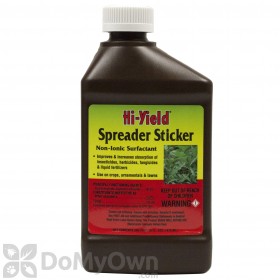If you've been doing your own lawn care and applying post-emergent herbicides, you may have run across ester and amine in the names of many herbicide products. But what are ester and amine herbicides, and does it matter as a homeowner doing your own lawn care which type of weed killer you choose?
Let's look at the advantages and considerations of ester and amine herbicide formulations to help you make the best selection to increase your weed control.
Herbicide Formulations for Weed Control

Before we dive into the differences between ester-formulated herbicides and amine-formulated herbicides, it's important to understand how herbicides are built. Every post-emergent weed killer is comprised of both active ingredients--or those that control the weeds--and inert ingredients--such as compatibility agents, spreaders, or stickers--that can help boost the effectiveness of the product.
Popular herbicide active ingredients like 2,4-D, triclopyr or dicamba can be produced with different formulations to give the finished product unique features, such as increased uptake in the plant or ease of application. These formulations can make the active ingredient more available for use across a wider variety of settings than if it had been offered as a single formulation type.
This is where ester and amine formulations come in. Esters and Amines are two groups of chemical structures. In lawn care, we often see these in liquid post-emergent herbicide formulations. Ester herbicides are produced from the esterification, or adding of alcohol, to the active ingredients while Amine herbicides contain the amine salts of the active ingredients.
Both the ester and amine herbicide formulations have properties that make them more suitable for specific different use cases.
Ester Herbicides
You may be familiar with the herbicides Triclopyr Ester or Turflon Ester. Both are the Ester formulation of their respective active ingredients.
Ester herbicides typically provide better weed control when applied during cooler temperatures. They provide excellent weed control--usually better than amine herbicides--during the cooler spring months of March, April, and early May.
As the temperatures increase, ester herbicides tend to become more volatile, or evaporate more easily, when compared to amine formulations due to having a higher vapor pressure. This volatility can also cause drift onto desirable plants causing unintended damage.
In warmer weather under strong sunlight and heat, some ester formulations can cause injury to desirable turf. You may hear this increase in activity being referred to as the herbicide being "hot". It's important to always follow the product label for any temperature application restrictions to avoid turf injury when using ester herbicides in the summer months.
The ester formulation also enhances the ability of active ingredients to penetrate the waxy cuticle of plant leaves, allowing for faster absorption and more efficient weed control. Esters are not water soluble--meaning they do not mix well with water. Many of the finished herbicide products are oil-based emulsifiable concentrates, which allow them to dissolve into water. This characteristic allows the herbicide to more readily be absorbed into the plant's waxy leaves.
Because of their fast action and efficacy, ester herbicides are commonly used to control broadleaf weeds in lawns. They can be used on stubborn and hard-to-kill weeds such as clover, plantain, dandelions, and other broadleaf weeds. Ester herbicides tend to have a stronger odor, which may be a consideration depending on the application site.
Being mindful of temperature considerations, Ester Herbicides can be a great option for treating hard-to-kill weeds in cooler temperatures.
Amine Herbicides
The amine formulation of an herbicide contains the amine salts of the active ingredient. One of the most popular types of this herbicide formulation is 2,4-D Amine, where you may see the active ingredient listed as Dimethyamine Salt of 2,4-D.
Amine herbicides are more water soluble than esters, meaning they mix in water, but do not penetrate the waxy cuticle on plants as well as ester herbicides. This means that amines will generally have a slower absorption rate into the plant through the waxy leaf surface, but they usually have better root uptake.
Amines are also better suited to be used in areas where you want to protect adjacent plants, including in areas near desirable ornamentals or in landscaped areas. Amine herbicides tend to be less volatile than ester herbicides, meaning they have a lower risk of vaporizing and drifting onto nearby plants. This reduces the risk of doing unintentional damage to nearby desirable plants.
This lower volatility also means Amine herbicides can be applied in a greater range of temperatures making them suitable for application in different seasons. In the warmer months, amine herbicides provide the same level of weed control as ester formulations, but with less volatility.
Amine herbicides are excellent at controlling a wide range of weeds, including broadleaf weeds. Amine herbicides also tend to have a lower odor than Ester herbicides, which may be a consideration for some applications.
Now that you know the difference between Ester Herbicides and Amine Herbicides, you may be asking yourself which one is best to use?
The answer: it really depends on the situation.
Using the above guidelines, take into consideration the temperature and weather conditions you are treating in, the type of weeds you are trying to control, the area where you are trying to control weeds and desirable plants nearby, and what you are looking to get out of your post-emergent herbicide application. You may find that using a combination of ester and amine formulations at different points throughout the year will give you the best weed control results.
For more detailed instructions and recommendations on how to apply liquid and granular herbicides, read our guide here.
Want to prevent weeds for growing in your lawn? Check out our pre-emergent herbicides and our DoMyOwn Turf Box Subscription Program.
If you have any questions about selecting the right herbicide formulation for your lawn, give our expert customer service team a call at 866-581-7378 or email [email protected].

















